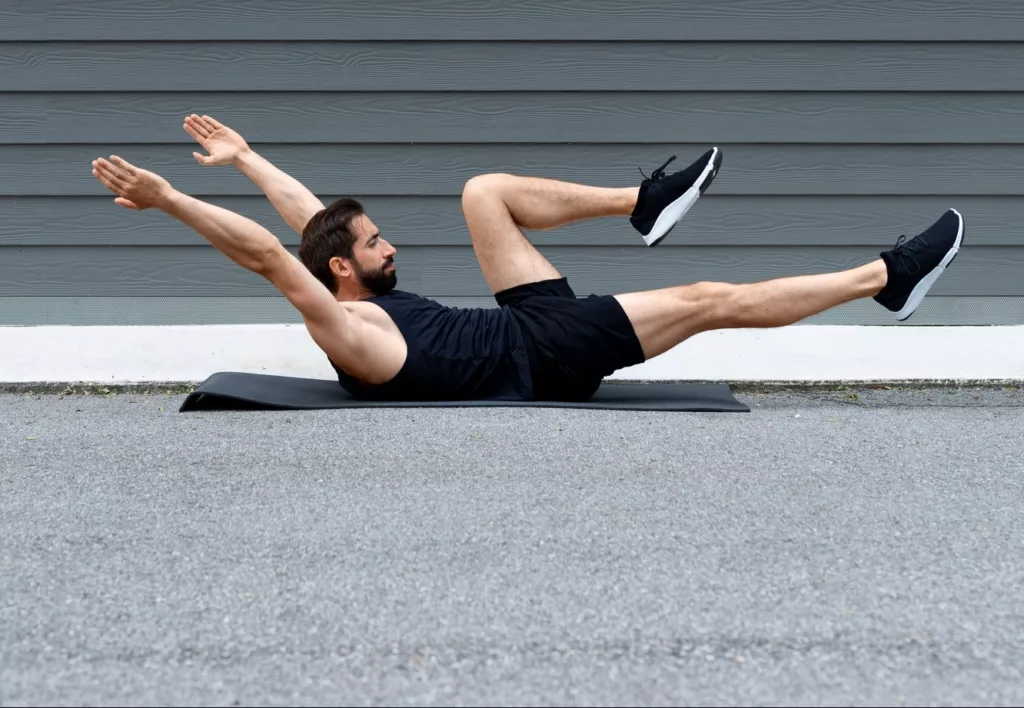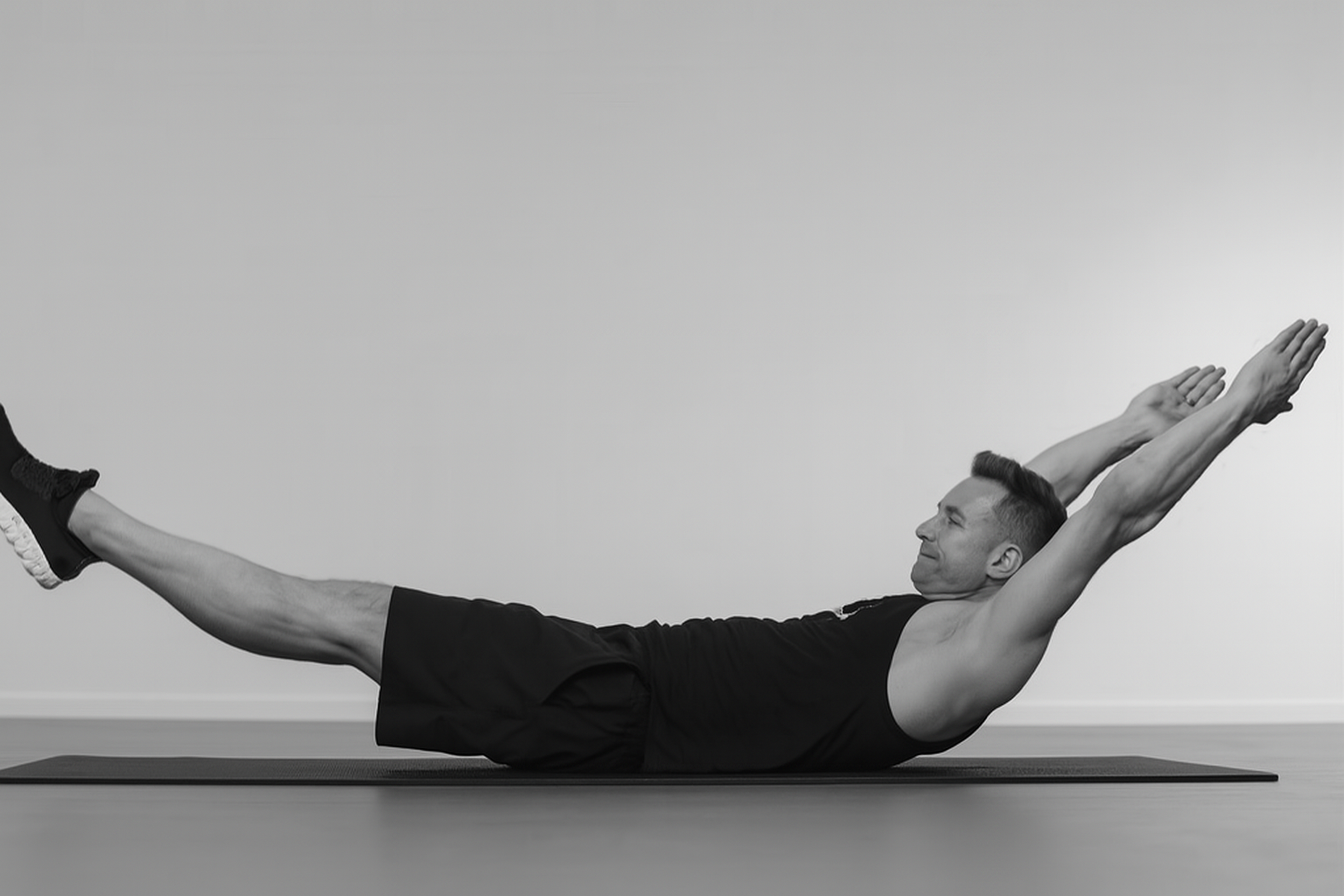So, tell me if this sounds familiar.
You lie down on the floor, arms stretched above your head, legs straight and hovering just a few inches off the ground.
Everything tight, you take a deep breath and brace your core like you’re about to take a punch from Tyson.
And then… ZAP.
Your lower back starts burning like someone’s aiming a hairdryer on high directly at your spine.
And you’re only eight seconds in.
You’re not alone. We’ve all been there.
And no, it doesn’t necessarily mean your form is wrong.
In fact, the fun (or painful) part is exactly this: you can have picture-perfect form, and still feel your lower back on fire.
Let’s dive into why that happens. And what you can actually do about it.
Hollow Holds: The Real Core Test

Hollow body holds look easy—until you actually try them.
Gymnasts use them. Calisthenics athletes. CrossFitters. Olympians. Even your neighbor who planks on the balcony.
Why?
Because it’s one of the few exercises that forces you to maintain total, controlled tension in your core, with your pelvis stable and your spine protected.
But be warned: this isn’t your basic gym crunch.
This is all about isometric tension, coordination, and most of all, your ability to hold a posterior pelvic tilt under load.
In simple terms: if your deep core muscles (like your transverse abdominis) aren’t ready, your body will call for backup from the nearest available area.
And unfortunately, that means your lower back.
Perfect setup: treat your position like a pre-flight checklist
Before you lift your legs or reach your arms out, treat your starting position like a ritual of precision.
Here’s a simple but effective 8-step setup:
- Lie on a stable surface, not too soft. A thin mat is fine, but skip the bed, blankets, or slippery floors.
- Place your arms alongside your body and bend your knees, feet on the floor.
- Take a deep breath, then exhale while gently pressing your belly button toward the floor. This activates your transverse abdominis.
- Now tilt your pelvis into posterior tilt: imagine “flattening” your lower back against the ground. Don’t force it—just feel solid contact.
- Raise your arms above your head, fully extended, without letting your ribs flare. If your ribs “pop up,” you’ve lost control.
- Lift your shoulders a few inches off the ground: no need to “tug your neck,” just act like you’re trying to see your toes.
- Only now, extend your legs, keeping the angle that lets your back stay glued to the floor.
- Breathe. Hold. Even 5 seconds is enough—if you do it right.
This 8-step setup isn’t just for beginners.
It’s the best way to check whether you’re actually in control… or just mimicking proper form.
“But my form is perfect…” – Yeah, but that’s not enough
You’ve got the pelvic tilt.
You’ve braced your abs.
You even have your chin tucked and toes pointed like a dancer from the Bolshoi.
And yet your lower back screams.
Why?
Because visual form doesn’t always equal internal control.
What truly matters is your ability to maintain that shape under stress.
Not just getting into position—but staying there when everything inside you wants to collapse.
And if your abs start to fail after just a few seconds?
The tension shifts somewhere it shouldn’t.
Enter: your lower back.
As if your lumbar spine were saying, “So… nobody else is doing their job? Guess I’ll do it. Again.”
Your hip flexors: the silent saboteurs
Let’s be clear: hollow holds are also a hip flexor test.
When you extend your legs—especially when they’re straight out front—you bring in muscles like the iliopsoas, rectus femoris, and their less popular friends.
If these muscles are overly active or dominant, they pull the pelvis forward, creating excessive lumbar lordosis (aka an exaggerated lower back curve).
The result?
Your posterior tilt collapses, and your spine bends the wrong way.
And you… suffer.
Not because you’re weak.
But because there’s a mismatch between what you want to do and what your muscles can actually support.
What you can do (without sending hollow holds to hell)
Breathe.
You don’t have to give up on them—but you do need to adapt them to your current level.
Try these smart moves starting today:
- Shorten the lever
Bend your knees. Bring your thighs closer to your chest. Less lever, less load, better control of pelvic tilt. - Do hollow rocks with bent legs
Teach your core to move under control, not just hold still. - Break up the time
Instead of one 30-second set, do 3 sets of 10 seconds. With full rest. Quality > quantity. Always. - Train pelvic tilt with bodyweight
Drills like posterior pelvic tilts (flat on your back) are essential. They teach you to move your pelvis with intention. - Stretch and relax your hip flexors
If they’re tight, your pelvis will tilt forward even if your abs are strong. Use static lunges, psoas stretches, foam rolling. - Strengthen your lower abs in isolation
Think reverse crunches, controlled leg raises, hanging knee raises with tilt: this is your daily bread for control.
And if even with all that your lower back still hurts?
Take a step back. Seriously.
You don’t need to be an ab martyr.
If the pain is sharp, breath-stealing, or makes you stiffen up, you’re not building core strength—you’re just stressing your spine.
You’re better off doing planks, bird dogs, stir-the-pot drills, or a solid leg raise with control, rather than forcing a position your body isn’t ready for yet.
Want progress?
You need time. You need patience. But more than anything—you need to listen to your body. Not silence it.
Watch your breath: are you holding your air without noticing?
One of the most overlooked (but super common) mistakes during hollow body holds is holding your breath.
When that happens, your diaphragm locks up, internal pressure spikes, and… guess who pays the price?
Your lower back.
Breathing with control during the hold is key.
Try inhaling through your nose and exhaling slowly through your mouth, keeping your abs engaged but not bricked-up stiff.
A good breath creates stable intra-abdominal pressure that truly protects your spine.
Without breath, your core doesn’t fire at full capacity.
It’s like trying to drive a sports car… without gas.
Your glutes: the forgotten heroes of core work
Surprise: hollow holds aren’t just about abs.
If activated properly, your glutes help maintain the pelvic tilt, stabilize the entire posterior chain, and take pressure off your lower back.
But often… they’re asleep.
Literally.
Try contracting your glutes during the hold—even if it feels like extra work.
If you feel them “wake up,” you’re doing smart training.
It’s not a side detail—it’s a game changer.
Real-life context: when your back burns in hollow holds but feels fine in squats or deadlifts
Ever notice that even though your back burns during hollow holds, it’s perfectly fine in squats or deadlifts?
Sounds like a paradox. But it’s not.
Those lifts let you create tension through solid support (the ground, the barbell), whereas in hollow holds, you’re suspended—rootless.
It’s like standing on a surfboard vs. standing on the sidewalk.
In short: hollow body holds demand finer, deeper control than heavy lifts.
So if you feel strong under the barbell but weak on the floor—don’t stress: you’re not broken, just misaligned.
And that’s exactly where your biggest growth can happen.
RELATED:》》》 What are the common problems with calisthenics?
Conclusion
I get it. “Frustrating” doesn’t even begin to cover it.
You’re doing everything right, but your body seems to revolt.
And yet the truth is: your back isn’t the enemy.
It’s just stepping in because someone else is sleeping on the job.
You’ve got two choices:
- Get mad at your lower back.
- Understand why it’s happening and work to rebalance the whole system.
Option two will take you way further.
Got a similar story or a question? Drop it in the comments — let’s figure it out together.


